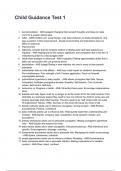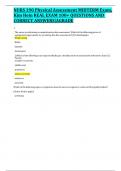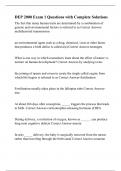Child Guidance Test 1
1. Accommodation - ANS-(piaget) Changing their present thoughts and ideas to make
room for a greater refined idea
2. Adler - ANS-Children are: social beings, may base behavior on faulty perceptions, and
play a position in their improvement ; Social environments and interactions have an
effect on personal
3. improvement
4. Adlerians consider that the simplest method in dealing with hard baby behaviors is
regularly - ANS-helping kids to feel valued, significant, and competent due to the fact "a
misbehaving infant is a discouraged child"
5. Adult-infant dialogue or discourse - ANS-(vygotsky) Talking approximately duties that a
baby can accomplish with out grownup assist
6. assimilation - ANS-(piaget)Taking in new statistics into one in every of their present
standards
7. authoritarian links to child effects. - ANS-has a bad impact on children's development;
Poor shallowness, Poor strength of will, Fosters aggression, Does not forestall
unacceptable behavior
8. authoritative hyperlinks to baby results. - ANS-allows youngsters feel Safe, Secure,
Competent; facilitates youngsters develop: Empathy, Self-esteem, Core of private
values, Self-control, Self-duty
9. Autonomy vs. Disgrace or doubt - ANS-18months-three years; Encourage independence
when
10. feasible and safe; figure must try no longer to do the whole lot for the child however if the
child fails at a particular project they need to now not criticize the child for screw ups and
injuries (specially while toilet training). The aim needs to be "self control with out a lack
of shallowness" (Gross, 1992). Success on this level will cause the virtue of will.
11. Simple methods adults use to influence youngsters: Giving remarks - ANS-Positive,
unconditional; Positive, conditional
12. basic methods adults use to influence kids: Helping kids trade their understanding and
mindset - ANS-Gentle, company, type, empathetic; Avoid sarcasm, threats, and
accusations
13. primary techniques adults use to persuade youngsters: Helping youngsters apprehend
'why' - ANS-Explain the reasons for limits
14. basic tactics adults use to steer youngsters: Instruction/coaching - ANS-Intentional and
specific; Encouragement, steerage, coaching
15. fundamental procedures adults use to persuade kids: Managing the child's surroundings
- ANS-Space, substances, schedule
16. simple approaches adults use to influence children: Modeling - ANS-Demonstration
17. basic processes adults use to persuade children: Stating expectations for suitable
conduct - ANS-Clear, direct, confined
, 18. toddler guidance theories that concentrate on how children assemble know-how. -
ANS-Piaget, Dewey, and Vygotsky
19. child guidance theories that focus on mental, emotional, and social getting to know
needs. - ANS-Erikson
and Maslow
20. toddler steerage theories that focus on systems in which youngsters exist. -
ANS-Ecological Theory and
Family Systems Theory
21. Children want these Cognitive Competencies in Order to Show Prosocial Behavior -
ANS-Sense of self; Identity needs; Make things show up; Language; Memory
22. Children need these Emotional Competencies in Order to Show Prosocial Behavior -
ANS-Decoding emotion in some other man or woman's face, Responding to the feelings
of others, and Demonstrating empathy
23. Cognitive Competencies in Order to Show Prosocial Behavior- Identity needs -
ANS-Must be capable of apprehend what any individual needs
24. Cognitive Competencies in Order to Show Prosocial Behavior- Language - ANS-Needs
good enough language abilities to describe how others or themselves may also feel
25. Cognitive Competencies in Order to Show Prosocial Behavior- Make matters show up -
ANS-Must be able to see oneself as a person who can make things occur
26. Cognitive Competencies in Order to Show Prosocial Behavior- Memory - ANS-Must be
state-of-the-art sufficient to allow him to preserve in someone's need in mind long
enough to behave on it
27. Cognitive Competencies in Order to Show Prosocial Behavior- Sense of self -
ANS-Needs to realize that she or he is an character and separate from other people
28. Concrete Operations Stage - ANS-(piaget) 8 to twelve years of age; Logical thinking
more subtle while the usage of concrete gadgets
29. Cooperating - ANS-Working collectively willingly to perform a job or mission
30. Decoding emotion in any other individual's face - ANS-Ability to have a look at
someone's or animal's face and make sense of his or her facial expression
31. Define developmentally suitable exercise and its capabilities, and give an explanation for
why we use it with children start to age eight. Be capable of apprehend examples of
developmentally appropriate and inappropriate practice. - ANS-
32. demandingness - ANS-refers to an adult's knowledge and competencies: In putting
limitations, limits, and expectations, In monitoring and supervising children, With
guidance strategies, and In confronting children while necessary
33. Demonstrating empathy - ANS-Ability to take part in some other character's or animal's
emotions
34. Describe different oblique steerage that includes curriculum, sports, and materials in the
school room, and the way they indirectly guide kids. - ANS-
35. Dewey - ANS-Children assemble information; Four primary interests of children;
Learner's interest-kids are clearly inquisitive and interested by their world; Creating study






